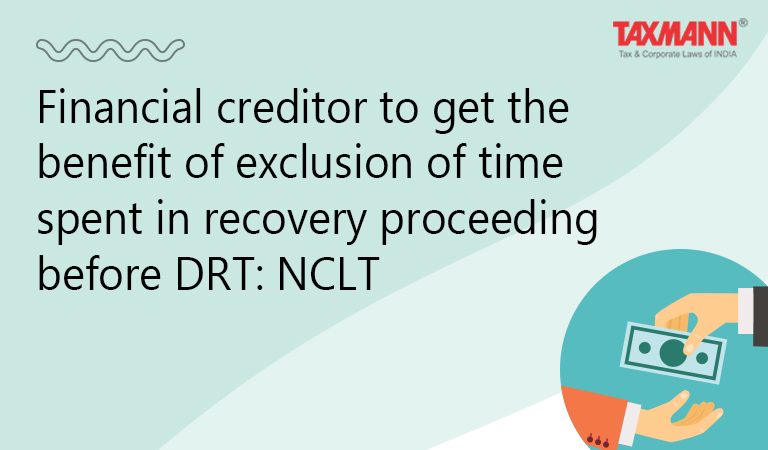Financial creditor to get the benefit of exclusion of time spent in recovery proceeding before DRT: NCLT
- Blog|News|Insolvency and Bankruptcy Code|
- 2 Min Read
- By Taxmann
- |
- Last Updated on 12 October, 2021

Case Details: JM Financial Asset Reconstruction Co. Ltd. v. Samay Electronics (P.) Ltd. - [2021] 131 taxmann.com 11 (NCLT - Ahd.)
Judiciary and Counsel Details
-
- Madan B. Gosavi, Judicial Member
- Navin Pahwa, Ld Sr. Counsel and Raju Kothari, Ld. Counsel for the Appellant.
- Vishwas Shah, Ld. Counsel for the Respondent.
Facts of the Case
In the given case, the bank had granted and disbursed the loan to the corporate debtor in the year 1998 and the terms of repayment of the loan were extended from time to time. Since the corporate debtor committed default persistently, in the year 2010, the bank filed recovery proceedings in DRT after serving notice under SARFAESI Act, 2002.
On 26-10-2010, the bank and the corporate debtor arrived at a settlement, and accordingly, an award was passed in that proceeding based on consent terms.
Later on, the promoters of the corporate debtor filed an appeal against the consent decree before DRAT and that appeal was still pending.
However, the bank assigned debt to the financial creditor, an asset reconstruction company, by deed of assignment dated 26-2-2014 and the financial creditor continued with the appeal in DRAT.
On 28-5-2018, the financial creditor filed an application under section 7 against the corporate debtor to initiate CIRP of the corporate debtor on the ground that the corporate debtor committed default in paying a financial debt. Thereafter, the corporate debtor contested the claim on the ground that the claim was time-barred.
The NCLT passed the order of admission. However while doing so, both members of the Bench wrote separate orders. The Member technical held that continuous proceeding for the same debt was going on from 2010 and appeal was still pending in DRAT, Mumbai and, therefore, the CIRP against the corporate debtor was to be admitted whereas the Member Judicial held that time spent in the proceeding before DRT and DRAT (under SARFAESI Act) was not permitted to be excluded for the purpose of limitation to file instant proceedings and, therefore the claim was time-barred.
NCLT Held
The NCLT held that application under section 7 filed against the corporate debtor in 2018 for default that took place in 2014 was maintainable and was not barred as financial creditor got the benefit of exclusion of time spent in recovery proceedings against a corporate debtor before DRT. Thus, CIRP against the corporate debtor was to be admitted.
Case Review
-
- Sesh Nath Singh v. Baidyabati Sheoraphuli Co-Operative Bank Ltd. [2021] 125 taxmann.com 357/166 SCL 507 (SC) (para 15) followed.
List of Cases Referred to
-
- Sesh Nath Singh v. Baidyabati Sheoraphuli Co-Operative Bank Ltd. [2021] 125 taxmann.com 357/166 SCL 507 (SC) (para 9).
Disclaimer: The content/information published on the website is only for general information of the user and shall not be construed as legal advice. While the Taxmann has exercised reasonable efforts to ensure the veracity of information/content published, Taxmann shall be under no liability in any manner whatsoever for incorrect information, if any.

Taxmann Publications has a dedicated in-house Research & Editorial Team. This team consists of a team of Chartered Accountants, Company Secretaries, and Lawyers. This team works under the guidance and supervision of editor-in-chief Mr Rakesh Bhargava.
The Research and Editorial Team is responsible for developing reliable and accurate content for the readers. The team follows the six-sigma approach to achieve the benchmark of zero error in its publications and research platforms. The team ensures that the following publication guidelines are thoroughly followed while developing the content:
- The statutory material is obtained only from the authorized and reliable sources
- All the latest developments in the judicial and legislative fields are covered
- Prepare the analytical write-ups on current, controversial, and important issues to help the readers to understand the concept and its implications
- Every content published by Taxmann is complete, accurate and lucid
- All evidence-based statements are supported with proper reference to Section, Circular No., Notification No. or citations
- The golden rules of grammar, style and consistency are thoroughly followed
- Font and size that’s easy to read and remain consistent across all imprint and digital publications are applied





